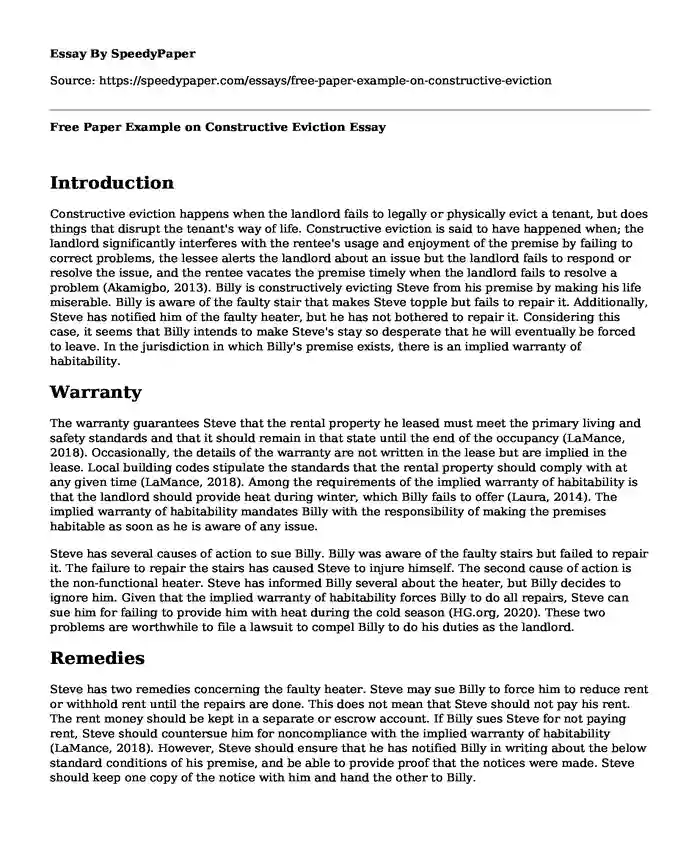Introduction
Constructive eviction happens when the landlord fails to legally or physically evict a tenant, but does things that disrupt the tenant's way of life. Constructive eviction is said to have happened when; the landlord significantly interferes with the rentee's usage and enjoyment of the premise by failing to correct problems, the lessee alerts the landlord about an issue but the landlord fails to respond or resolve the issue, and the rentee vacates the premise timely when the landlord fails to resolve a problem (Akamigbo, 2013). Billy is constructively evicting Steve from his premise by making his life miserable. Billy is aware of the faulty stair that makes Steve topple but fails to repair it. Additionally, Steve has notified him of the faulty heater, but he has not bothered to repair it. Considering this case, it seems that Billy intends to make Steve's stay so desperate that he will eventually be forced to leave. In the jurisdiction in which Billy's premise exists, there is an implied warranty of habitability.
Warranty
The warranty guarantees Steve that the rental property he leased must meet the primary living and safety standards and that it should remain in that state until the end of the occupancy (LaMance, 2018). Occasionally, the details of the warranty are not written in the lease but are implied in the lease. Local building codes stipulate the standards that the rental property should comply with at any given time (LaMance, 2018). Among the requirements of the implied warranty of habitability is that the landlord should provide heat during winter, which Billy fails to offer (Laura, 2014). The implied warranty of habitability mandates Billy with the responsibility of making the premises habitable as soon as he is aware of any issue.
Steve has several causes of action to sue Billy. Billy was aware of the faulty stairs but failed to repair it. The failure to repair the stairs has caused Steve to injure himself. The second cause of action is the non-functional heater. Steve has informed Billy several about the heater, but Billy decides to ignore him. Given that the implied warranty of habitability forces Billy to do all repairs, Steve can sue him for failing to provide him with heat during the cold season (HG.org, 2020). These two problems are worthwhile to file a lawsuit to compel Billy to do his duties as the landlord.
Remedies
Steve has two remedies concerning the faulty heater. Steve may sue Billy to force him to reduce rent or withhold rent until the repairs are done. This does not mean that Steve should not pay his rent. The rent money should be kept in a separate or escrow account. If Billy sues Steve for not paying rent, Steve should countersue him for noncompliance with the implied warranty of habitability (LaMance, 2018). However, Steve should ensure that he has notified Billy in writing about the below standard conditions of his premise, and be able to provide proof that the notices were made. Steve should keep one copy of the notice with him and hand the other to Billy.
The copy Steve keeps could serve as the proof of notice about the issue. Steve has the right to terminate his lease or make repairs that do not exceed the rent for a single month (HG.org, 2020). Steve can leave the premise without paying the rent that would be due under the lease period. Steve might also sue Billy for the damages since Billy knew about the problem. In the case that Steve decides to make the repairs, he should document the substandard living conditions by taking photographs and safeguarding all receipts for the repair expenses (LaMance, 2018).
Conclusion
Thus, Steve should allow the landlord a significant amount of time of about 30 days for him to address issues or execute repairs (LaMance, 2018). If Billy does not address the issues, then Steve can proceed to implement the remedy that he chooses. Some repairs may need time to effect, but Steve's case is quite simple. The stair and heater can be repaired within a short time. In case Billy fails to do the repairs in time, Steve should have third party inspectors like health experts or building experts view the property. The third-party can be used to verify the claims by the tenant.
References
Akamigbo, C. (2013, Jul 31). Constructive eviction.
https://real-estate-law.freeadvice.com/real-estate-law/landlord_tenant/constructive_eviction.htm
HG.org. (2020). What is the implied warranty of habitability and why does it matter?
https://www.hg.org/legal-articles/what-is-the-implied-warranty-of-habitability-and-why-does-it-matter-43954
LaMance, K. (2018, Mar 4). Implied warranty of habitability lawyers.
https://www.legalmatch.com/law-library/article/implied-warranty-of-habitability-lawyers.html
Laura. (2014, Jul 14). Constructive eviction. Tenant's Resource Center. https://www.tenantresourcecenter.org/constructive_eviction.
Cite this page
Free Paper Example on Constructive Eviction. (2023, Nov 26). Retrieved from https://speedypaper.net/essays/free-paper-example-on-constructive-eviction
Request Removal
If you are the original author of this essay and no longer wish to have it published on the SpeedyPaper website, please click below to request its removal:
- Essay Example on Minimizing Maternal Mortality by Over Three-Quarters
- Essay Example on the Legal Environment of Business
- The Functions of the INTERPOL, Free Essay for Students
- Essay Example on Legal Form of Business
- The Top Five Theoretical Frameworks That Best Explain the Causes of Crime. Essay Example
- Essay on Regulatory vs. Allocative Health Policies: What's the Difference?
- Paper Example. Drug Control and Intervention
Popular categories





